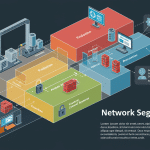
The Human Factor: Fortifying Your Manufacturing Cybersecurity
April 25, 2025
Network Segmentation: Fortifying Manufacturing Against Cyber Threats
April 27, 2025Navigating the Risks of Connected Devices in Your Plant
The manufacturing landscape is undergoing a significant transformation, driven by the increasing adoption of smart technologies and interconnected systems. Among these advancements, the use of tablets, smartphones, and other mobile devices has become increasingly prevalent on the plant floor. These devices offer numerous benefits, from real-time data access and streamlined workflows to enhanced communication and improved efficiency. However, this increased connectivity also introduces a new layer of cybersecurity risks that businesses, particularly small and medium-sized manufacturers, must address proactively.
Gone are the days when the plant floor operated as an isolated environment. Today, mobile devices connect directly to operational technology (OT) networks, enterprise IT systems, and the cloud, blurring the lines between traditionally separate domains. While this integration offers undeniable advantages, it also creates potential entry points for cyberattacks that could compromise sensitive data, disrupt operations, and even jeopardize the safety of personnel and equipment.
Understanding the Unique Risks
The risks associated with mobile devices in a manufacturing environment differ in several key aspects from those encountered in typical office settings:
OT System Vulnerabilities:
Connecting mobile devices to OT networks can expose critical industrial control systems (ICS) to vulnerabilities that were previously shielded. Malware designed for IT systems can potentially disrupt or even damage physical equipment if it gains access to the OT network through an unsecured mobile device.
Physical Security Threats:
The harsh conditions of a plant floor, including dust, extreme temperatures, and the constant movement of personnel and equipment, increase the risk of physical damage or loss of mobile devices. A lost or stolen device can provide unauthorized access to sensitive information and control systems if not properly secured.
Human Error:
Plant floor employees may not always have the same level of cybersecurity awareness as office staff. This can lead to risky behaviors such as connecting to unsecured Wi-Fi networks, downloading unapproved applications, or falling victim to phishing attempts on their mobile devices.
Data Security and Compliance:
Mobile devices used in manufacturing often handle sensitive data related to production processes, quality control, inventory management, and even intellectual property. Ensuring the confidentiality, integrity, and availability of this data on mobile devices is crucial for maintaining operational efficiency and meeting regulatory compliance requirements.
Best Practices for Mobile Device Security in the Plant
To effectively manage the risks associated with mobile devices in your manufacturing operations, consider implementing the following best practices:
1. Develop a Comprehensive Mobile Device Security Policy:
This policy should outline acceptable use guidelines, security protocols, data access restrictions, and procedures for handling lost or stolen devices. Ensure all employees are thoroughly trained on this policy.
2. Implement Strong Authentication and Authorization Measures:
Utilize strong passwords, multi-factor authentication (MFA), and biometric security features to control access to mobile devices and applications. Implement role-based access control to ensure employees only have access to the data and systems they need to perform their jobs.
3. Secure Network Segmentation:
Isolate your OT network from your IT network and implement strict firewall rules to control traffic between the two. Consider creating a separate, secure Wi-Fi network specifically for authorized mobile devices used on the plant floor.
4. Employ Mobile Device Management (MDM) Solutions:
MDM software allows you to remotely manage and secure mobile devices, including enforcing security policies, deploying applications, tracking device location, and remotely wiping data in case of loss or theft.
5. Regularly Patch and Update Software:
Ensure that the operating systems and applications on all mobile devices are regularly updated with the latest security patches to address known vulnerabilities.
6. Implement Data Encryption:
Encrypt sensitive data both at rest on the device and in transit to protect it from unauthorized access.
7. Conduct Regular Security Awareness Training:
Educate your plant floor employees about the specific cybersecurity risks associated with mobile devices in their environment and train them on best practices for secure usage.
8. Establish Incident Response Procedures:
Develop a plan for responding to security incidents involving mobile devices, including procedures for identifying, containing, and remediating breaches.
9. Regularly Monitor and Audit Mobile Device Activity:
Implement tools and processes to monitor the usage of mobile devices on your network and audit access logs for any suspicious activity.
The Path to a Secure and Connected Plant
Embracing mobile technology in your manufacturing plant offers significant advantages, but it’s crucial to do so with a strong focus on security. By understanding the unique risks and implementing robust security measures, you can harness the power of connected devices while safeguarding your operations and valuable assets.
Ready to strengthen your plant’s mobile device security posture?
Contact Krypto IT today for a free consultation. Our team of cybersecurity experts based right here in Houston, Texas, can help you develop and implement a comprehensive strategy to manage the risks of a connected manufacturing environment and ensure the security of your small to medium-sized business.
Call us at 713-526-3999 or visit our website at www kyrptocybersecurity.com to schedule your free consultation.
#MobileDeviceSecurity #ManufacturingSecurity #OTSecurity #ICS #Cybersecurity #KryptoIT #HoustonTech #SMBSecurity




